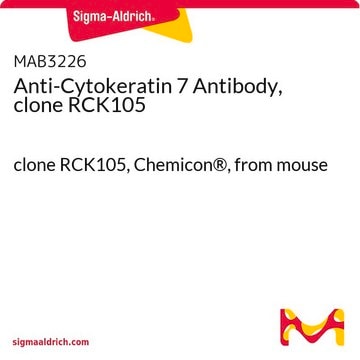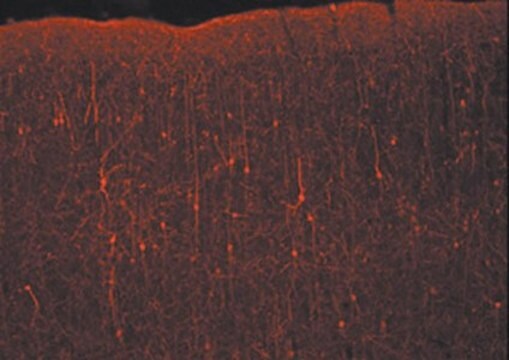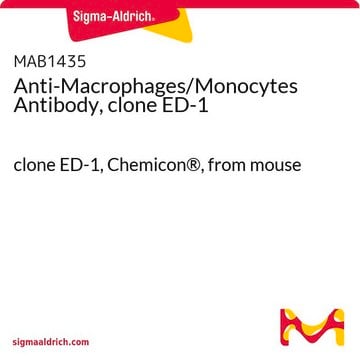AP182R
Donkey Anti-Rabbit IgG Antibody, Rhodamine conjugate, Species Adsorbed
Chemicon®, from donkey
Sign Into View Organizational & Contract Pricing
All Photos(1)
About This Item
UNSPSC Code:
12352203
eCl@ss:
32160702
NACRES:
NA.46
Recommended Products
biological source
donkey
Quality Level
conjugate
TRITC conjugate
rhodamine conjugate
antibody form
F(ab′)2 fragment of affinity isolated antibody
antibody product type
secondary antibodies
clone
polyclonal
species reactivity
rabbit
manufacturer/tradename
Chemicon®
technique(s)
immunofluorescence: suitable
shipped in
wet ice
target post-translational modification
unmodified
Related Categories
General description
Immunoglobulin G (IgG), is one of the most abundant proteins in human serum with normal levels between 8-17 mg/mL in adult blood. IgG is important for our defence against microorganisms and the molecules are produced by B lymphocytes as a part of our adaptive immune response. The IgG molecule has two separate functions; to bind to the pathogen that elicited the response and to recruit other cells and molecules to destroy the antigen. The variability of the IgG pool is generated by somatic recombination and the number of specificities in an individual at a given time point is estimated to be 1011 variants.
Specificity
Rabbit IgG
WAVELENGTH:
Absorption peak = 550nm, Emission peak = 570 nm.
WAVELENGTH:
Absorption peak = 550nm, Emission peak = 570 nm.
Application
Donkey anti-Rabbit IgG Antibody, Rhodamine conjugate, Species Adsorbed is an antibody against Donkey Rabbit IgG for use in IF.
Research Category
Secondary & Control Antibodies
Secondary & Control Antibodies
Research Sub Category
Secondary Antibodies Adsorbed for Dual Labeling
Secondary Antibodies Adsorbed for Dual Labeling
Suggested dilution for most applications: 1:50-1:200
Optimal working dilutions must be determined by end user.
Optimal working dilutions must be determined by end user.
Physical form
Lyophilized. Buffer = 0.01 M Sodium Phosphate, 0.25 M NaCl, pH 7.6 with 15 mg/mL BSA, and 0.05% sodium azide.
RECONSTITUTION:
Reconstitute with 500 μL of sterile distilled water.
RHODAMINE/PROTEIN:
Approximately 0.52 (A550/A280)
RECONSTITUTION:
Reconstitute with 500 μL of sterile distilled water.
RHODAMINE/PROTEIN:
Approximately 0.52 (A550/A280)
Storage and Stability
Maintain lyophilized product at 2-8°C for up to 12 months. After reconstitution the product is stable for several weeks at 2-8°C as an undiluted liquid. For extended storage after reconstitution, add an equal volume of glycerol to make a final concentration of 50% glycerol followed by storage at -20°C in undiluted aliquots for up to 12 months. Please note the concentration of protein (and buffer salts) will decrease to one-half of the original after the addition of glycerol. Avoid repeated freeze/thaw cycles.
Legal Information
CHEMICON is a registered trademark of Merck KGaA, Darmstadt, Germany
Disclaimer
Unless otherwise stated in our catalog or other company documentation accompanying the product(s), our products are intended for research use only and are not to be used for any other purpose, which includes but is not limited to, unauthorized commercial uses, in vitro diagnostic uses, ex vivo or in vivo therapeutic uses or any type of consumption or application to humans or animals.
Not finding the right product?
Try our Product Selector Tool.
Hazard Statements
Precautionary Statements
Hazard Classifications
Aquatic Chronic 3
Storage Class Code
11 - Combustible Solids
WGK
WGK 3
Certificates of Analysis (COA)
Search for Certificates of Analysis (COA) by entering the products Lot/Batch Number. Lot and Batch Numbers can be found on a product’s label following the words ‘Lot’ or ‘Batch’.
Already Own This Product?
Find documentation for the products that you have recently purchased in the Document Library.
N Sae-Ung et al.
European journal of haematology, 74(4), 315-323 (2005-03-22)
Erythropoietin (EPO) and interferon-gamma (IFN-gamma) added to human erythroid progenitor cells purified from peripheral blood (erythroid colony-forming cells; ECFC) significantly reduces apoptosis as assessed by flow cytometry (FCM) using annexin V. To clarify the role of NF-kappaB in the regulation
A mutation in the nuclear pore complex gene Tmem48 causes gametogenesis defects in skeletal fusions with sterility (sks) mice.
Akiyama, K; Noguchi, J; Hirose, M; Kajita, S; Katayama, K; Khalaj, M; Tsuji, T; Fairfield et al.
The Journal of Biological Chemistry null
Nopporn Jongkamonwiwat et al.
The European journal of neuroscience, 23(10), 2701-2711 (2006-07-05)
Several independent investigations have demonstrated the presence of opioid peptides in the inner ear organ of Corti and in particular in the efferent nerve fibers innervating the cochlear hair cells. However, the precise innervation pattern of opioid fibers remains to
Li-Wei Tung et al.
Nature communications, 7, 12199-12199 (2016-07-23)
Orexins are associated with drug relapse in rodents. Here, we show that acute restraint stress in mice activates lateral hypothalamic (LH) orexin neurons, increases levels of orexin A and 2-arachidonoylglycerol (2-AG) in the ventral tegmental area (VTA), and reinstates extinguished
Takeshi Onishi et al.
The Journal of physiology, 597(13), 3441-3455 (2019-05-16)
Neuropathic pain spreads spatially beyond the injured sites, and the mechanism underlying the spread has been attributed to inflammation occurring in the spinal cord. However, the spatial spread of spinal/cortical potentiation induced by conduction block of the peripheral nerves can
Our team of scientists has experience in all areas of research including Life Science, Material Science, Chemical Synthesis, Chromatography, Analytical and many others.
Contact Technical Service





